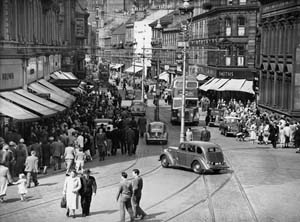
One of the most important streets of ancient Dundee, the name of the Murraygate is commemorative of the Battle of Bannockburn, for tradition has it that the name was given to the street in honour of the derring-do of the Earl of Moray, who was henchman of the Bruce at Bannockburn, and who came to Dundee with the King in October 1314.
In the days when the Town House stood in the Seagate, the Murraygate was the central business quarter of the burgh. The northern end of the street was guarded by a gate, and the walls of defence were the back dykes of the gardens of Murraygate householders. Until nearby the end of the sixteenth century the city was without the protection of a surrounding wall, and the greatest care was taken to see that “all back dykes were biggit up and repairit sufficiently quhair the same are decayit or broken down”. It was enjoined moreover, that the “back yetts of every tenement be made sufficient with locks, bands, or other necessities, and closit every nicht” under the pain of a fine of forty shillings. People found to have climbed the walls were fined eight shillings “to be applyit to Kirk wark”, and so in every way it was made sure that the gates of the town were "steukit and made close". It is worthy of note that the defence of the Town Wall at the northern end of the Murraygate gave the soldiers of General Monk more trouble than they had at any other quarter of the burgh.
In January 1568 we find the Council resolving that the Murraygate Port be “repairit and biggit with all possible diligence be the Treasurer, with the assistance of Bailie Findlason, and that the money of unlaws appointit thereto be tollit and inbrocht for the repairing thereof”. But it was not till nearly twenty years later that the new Port was erected. The one end rested on the angle formed by the junction of the Cowgate, and the other stood on “Andro Masson’s heirs’ land beneath the Port”, where Panmure Street now is. When the erection was completed the Treasurer received instructions to cause bing the Murraygait Port, and mak the expenses thereof upon the tollbuith rents; and if the same should not serve, the Council obliged them to relieve him”, and they “disponit to Robert Bawand and Patrick Lowrie, masons, ane burgess-ship in recompense of their bounty, and skayth in the town’s wark in biggin the Murraygait Port; and agreed that the persons presentit be them be insert in the lockit buik”.
At the time the Murraygate was a fair example of an ancient Scottish burgh street. From the High Street at Rankine’s Court down to very near Meadow Entry, it was a vennel or lane, through which it was difficult to drive the mail coach. From Meadow Entry to the Cowgate the street was wider, but as the thoroughfare generally was blocked by carriers’ carts, hucksters’ barrows, and stands, the Broad of the Murraygate was not much wider than the Narrow of the Murraygate.
The Trades Hall at the east end of the High Street, the frontage of which was in line with the centre of Castle Street, divided the Murraygate from the Burnhead or Seagate. In rear of the Trades Hall was a narrow pass in which stood the famous shop of Toffee Reid. The Clydesdale Bank, erected in 1877–78 used to occupy the site of the ancient buildings in which the little toffee shop was a central feature.
Source: Dundee Year Book, 1914
